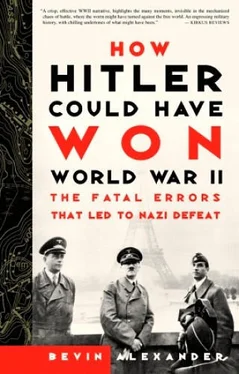Rommel blamed his superiors in the army high command. He was right in noting the reluctance of the senior generals to endorse a full-scale operation in Libya. But at the time Rommel didn’t know it was Hitler who had rejected a Mediterranean strategy, and Brauchitsch and Halder had adjusted their viewpoint to conform. The silence of Brauchitsch, Halder, Jodl, and Keitel in the presence of Rommel’s incredible gift speaks volumes, either about their lack of vision or about their fear of Hitler.
8 BARBAROSSA

THE PURPOSE OF MILITARY STRATEGY IS TO DIMINISH THE POSSIBILITY OF RESISTANCE. It should be the aim of every leader to discover the weaknesses of the enemy and to pierce his Achilles’ heel. This is how battles and wars are best won.
Such advice goes back at least to Sun Tzu in the fifth century B.C., but it is extraordinarily difficult for human beings to follow. The attack against the Soviet Union on June 22, 1941, is the most powerful example in the twentieth century of how a leader and a nation—in this case Adolf Hitler and Germany—can ignore clear, eternal rules of successful warfare, and pursue a course that leads straight to destruction.
Attacking Russia head-on was wrong to begin with, because it guaranteed the greatest resistance, not the least. A direct attack also forces an enemy back on his reserves and supplies, while it constantly lengthens the supply and reinforcement lines of the attacker. The better strategy is to separate the enemy from his supplies and reserves. That is why an attack on the flank is more likely to be successful.
Nevertheless Hitler could still have won if he had struck at the Soviet Union’s weakness, instead of its strength.
His most disastrous error was to go into the Soviet Union as a conqueror instead of a liberator. The Soviet people had suffered enormously at the hands of the Communist autocracy for two decades. Millions died when the Reds forced people off their land to create collective farms. Millions more were obliged to move great distances and work long hours under terrible conditions in factories and construction projects. The secret police punished any resistance with death or transportation to horrible prison gulags in Siberia. In the gruesome purges of the 1930s, Joseph Stalin had systematically killed all leaders and all military officers who, in his paranoid mind, posed the slightest threat to his dictatorship. Life for the ordinary Russian was drab, full of exhausting work, and dangerous. At the same time, the Soviet Union was an empire ruling over a collection of subjugated peoples who were violently opposed to rule from the Kremlin.
Vast numbers of these people would have risen in rebellion if Hitler’s legions had entered with the promise of freedom and elimination of Soviet oppression. Had Hitler done this, the Soviet Union would have collapsed.
Such a policy would not have given Hitler his Lebensraum immediately. But once the Soviet Union had been shattered, he could have put into effect anything he wanted to with the pieces that remained.
Hitler followed precisely the opposite course of action. His “commissar order” called for the instant shooting down of Communist party agents in the army. He sent Einsatzgruppen— or extermination detachments—to come behind the army and rout out and murder Jews. He resolved to deport or allow millions of Slavs to starve in order to empty the land for future German settlers.
Two days before the Germans struck, Alfred Rosenberg, Hitler’s commissioner for the regions to be conquered, told his closest collaborators: “The job of feeding the German people stands at the top of the list of Germany’s claims in the east…. We see absolutely no reason for any obligation on our part to feed also the Russian people.”
The genuine welcome that German soldiers received as they entered Soviet towns and villages in the first days of the campaign was quickly replaced by fear, hatred, and a bitter guerrilla war behind the lines that slowed supplies to the front, killed thousands of Germans, and increasingly hobbled the German army.
As wrong as this policy was, Hitler’s actual military plans were so false strategically that they could only succeed if the Red Army collapsed from internal stress. That, in fact, is what Hitler counted on. He did not expect to win by a superior method or concept, but by relying on the Russian army to disintegrate after a series of initial battles.
Great generals don’t win wars in this fashion. They don’t depend upon their enemies to make mistakes or give up. A great general relies upon his own ideas, initiative, skill, and maneuvers to put the enemy in a position where he must do the general’s bidding. A great general wins his battles before he fights them. He obligates the enemy to take positions he cannot defend or from which he cannot extricate himself.
Hitler’s greatest strategic mistake was his refusal to concentrate on a single, decisive goal. He sought to gain—all at the same time—three widely distant objectives: Leningrad, because it was the birthplace of Russian Communism; Ukraine and the Caucasus beyond, for its abundant foodstuffs, 60 percent of Soviet industry, and the bulk of the Soviet Union’s oil; and Moscow, because it was the capital of the Soviet Union and its nerve center.
Hitler wanted all of them. Indeed, he expected to reach the line Archangel–Caspian Sea in 1941. That is 300 miles east of Moscow, and only about 450 miles from the Ural Mountains. But Germany did not have the strength to achieve all these goals in a single year’s campaign. At best, it had the strength to achieve one.
Hitler scorned such a limitation, and ordered Army Group North to go for Leningrad, Army Group Center for Moscow, and Army Group South for Ukraine. These objectives, spread over the entire western face of the Soviet Union, could not possibly be coordinated. Leningrad is 940 airline miles from Odessa on the Black Sea. Each army group would be required to conduct a separate campaign. Because resources were to be divided in three directions, no single effort would have the strength to achieve a war-winning decision.
The task Hitler set for Germany was almost inconceivable. He hoped to seize a million square miles of the Soviet Union in 1941, a region the size of the United States east of the Mississippi. The campaign in the west, on the other hand, had been fought out in an area of 50,000 square miles, roughly the size of North Carolina or New York State. Therefore, the ratio of space to men was twenty times greater in the east than in the west.
Field Marshal Brauchitsch, commander of the army, and General Halder, chief of staff, wanted the primary objective to be Moscow, with forces concentrated in the center. They contended that conquest of Leningrad, Ukraine, and the Caucasus depended on defeating the Red Army. The main body of this army, or an essential part of it, would be met on the road to Moscow.
Stalin would be compelled to fight for Moscow. It was the hub of railroads, mecca of world Communism, headquarters of the highly centralized government, and a great industrial center employing more than a million workers.
Moreover, an attack into the center of the Soviet Union would turn the nation’s vastness—generally thought of as its greatest asset—into a liability. Once the Germans possessed Moscow’s communications node, Red Army forces on either side could not coordinate their efforts. One would be cut off from aid and succor to the other, and the Germans in the central position between the two could have defeated each separately.
Читать дальше



![Джонатан Димблби - Barbarossa - How Hitler Lost the War [calibre]](/books/385421/dzhonatan-dimblbi-barbarossa-how-hitler-lost-the-w-thumb.webp)









